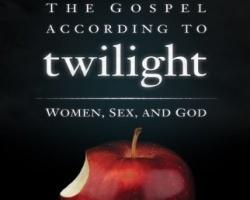With the next Twilight movie set to open Nov. 18, we wanted to help you identify and consider some of the spiritual and theological issues raised by these mega-popular vampire books and movies.
After my daughters came home for the holidays and repeatedly pleaded with me to read the Twilight books, I snuck off with one of them and a pot of coffee. Hours later, I emerged, enlightened. I now understand why my daughter had said I would want to read it. Tucked into the pages of these thick, vampiric novels were most of the basic questions of systematic theology. I was hooked.
I’m not alone. The Twilight books have sold more than 53 million copies worldwide, and the first three Twilight movies grossed $1.75 billion in global box office receipts. Author Stephenie Meyer is a Mormon, and her theological formation, along with her work as a mother and homemaker, are part of the reason she captures so brilliantly the imaginations of girls everywhere.
But is the gospel according to Twilight good news for girls and women? Is it consistent with Christian faith?
The undisputable good news is that life is sacred for Bella, for the vampires who choose not to drink her blood and for several other characters. This is true whether one reads the story through Catholic, Orthodox, Protestant or Mormon lenses.
Then things get tricky. When read through a traditional, patriarchal Christian lens, which is true for a vast number of readers, Bella and Edward look just like Adam and Eve in misogynist readings of Genesis. The beautiful and seductive Eve/Bella entices a perfect but vulnerable Adam/Edward with forbidden fruit—in this case, her own body and blood.
Viewed in this way, Twilight becomes indistinguishable from many other pop culture examples such as plumbing ads. The morally superior Adam/Edward resists her for a long time but finally caves. Who can blame him? He may be a vampire, but he is a man. First they must get married, even though Bella, 18 by this point in the saga, doesn’t want to wed.
Elements of the relationship between Edward and Bella make the hair stand up on feminist Christian necks, especially when adding in the bit where Bella scarcely survives the violence of her wedding night. Though broken and bruised the next morning, she begs for more. This part of the story is terrible news for girls and women—unless you read it through another lens, such as Stephenie Meyer’s.
The Eve story has an entirely different meaning in LDS theology, with Eve as a moral heroine who sacrifices her life so others can live. What is going on here? Is Bella a Christ figure, offering her body and blood for others’ salvation? Or is she a sex-hungry temptress who’s willing to go to hell if she can just have her guy? Is Bella fallen, redemptive or both?
Similar to Harry Potter, the Twilight Series has the potential to help readers bend toward the Light, especially if they are helped to think theologically about what they are reading.
Evangelism is also at the heart of the saga. In many ways, the Twilight saga gives voice to the questions and frustrations of millions of spiritual-but-not-religious young adults today. Anyone who cares about evangelism should take note. Within these pages we find wonderful social critiques, especially in regard to racial reconciliation, religious exclusivity and political and religious oppression.
While most of the applause for Twilight from interested religious folk has been directed toward the sexual abstinence theme (and Lord knows we need help in this department), I think the strongest Christian messages in the story have to do with justice and peace. The books also delve into the role of desire in spirituality. Despite significant problems with gender and abuse themes, the Twilight narrative is a captivating story in which theology plays an important role.
This article is adapted from The Gospel According to Twilight: Women, Sex and God with permission of Westminster John Knox Press. Content © 2011 Elaine A. Heath.




